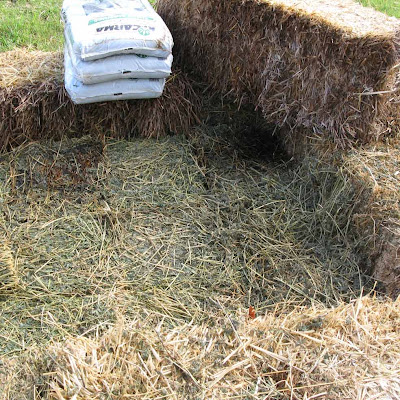I've always been somewhat keen on growing vegetables - when I was a kid my Dad had a Howard rotary hoe (imaginatively named 'Howard') and our whole front paddock was given over to vegie growing. One of my favourite tasks was to tuck a chicken under one arm and go and de-caterpillar the cabbages and broccoli. Being able to eat beans straight off the bush was just fab, and shop-bought vegies (or heaven forbid, frozen!) just didn't compare.
One of the things that's been on my to-do list for ages is 'Have an awesome vegie garden.' This new house - it's built on solid clay, and by 'solid' I mean 'there's a brickworks down the road'. Clay is not really a friend to gardeners, so I pulled out my trusty Stephanie Alexander's 'Kitchen Garden Companion' book and asked her advice. Stephanie always knows what to do. The solution jumped out. Clay = don't dig down, build up. No digging required!
 |
| Click on this - it'll probably be big enough should you like to read it. |
So, here's my opportunity to try Stephanie's recipe for a no-dig garden. The idea is you build up layers of material (lasagne style) and the growing plants get their roots down into it and ideally, thrive. You can even do it on top of concrete - a garden for anywhere! Our clay soil is almost concrete - I don't know how the grass survives.
First layer = a good whack of newspapers/cardboard. I don't want the grass growing up through the vegies.
I did get a little distracted by this article about Tom Waits, but hell... gardening is for enjoyment too, right? I added him to the pile once I'd read it.
I'm using bales of hay/lucerne as the edges for my garden. They're somewhat temporary and will break down into lovely rich mulch in a year or so. Plus I can try a bit of 'straw bale' gardening (growing things straight into the bale) as a side project.
Next is a thick layer of lucerne. Stephanie describes the process of disassembling the bale as 'peeling away like big Weet-Bixes' and she's completely right. Water it down with a couple of watering-cans full of seaweed mix, too.
Then comes a layer of manure (I'm using sheep) mixed in with Hydrocell. This is a very interesting product - it retains water and releases it slowly to the plant, meaning you don't need to water as often or as much. It's available at Centenary Landscaping Supplies here in Brisbane - and it was tricky to find. I'd looked about at various hardwares, garden and produce shops before Consulting The Internet to find a supplier. Darn it, I should have done that first.
Next is a thick layer of straw. Stephanie's recipe calls for 'pea straw' but you just can't get that in Brisbane. Ordinary straw will have to do - I hope that's not a fatal error. Wet it all down with a few more cans of seaweed fertiliser.Then, yet another layer of the manure/Hydrocell mixture.
The whole lot gets topped off with a thick layer of compost and watered. Apparently it'll be ready for planting straight into the compost mix in a few days - I'll give it a week.
So... here begins my no-dig vegetable garden experiment. One thing though... this costs an arm and a leg. I estimate that the materials to make two square metres of garden cost around three hundred dollars. If I'm not able to report back with some promising vegie-garden news I'm going to... be... very... disappointed!










1 comment:
looks really wonderful Ems!
Post a Comment